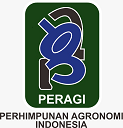Identification and Characterization of Ralstonia solanacearum Species Complex from Ginger (Zingiber officinale) in Semarang Regency, Indonesia
Abstract
The Ralstonia solanacearum species complex is a highly destructive plant pathogen with a remarkably broad range of hosts, and ongoing discoveries continue to expand its host list. In May 2023, a new type of bacterial wilt affecting ginger (Z. officinale) crops in Semarang Regency, Central Java was reported. Early symptoms included sudden withering of leaves in adult plants followed by complete wilting and darkening of the vasculature, ultimately leading to plant death. This research specifically investigates the spread of Ralstonia solanacearum Species Complex within ginger cultivation in Semarang Regency. Twenty bacterial isolates were collected from soil and diseased Z. officinale plants at twenty different locations. Physiological and biochemical analyses confirmed that the causative agent for Z. officinale bacterial wilt was Ralstonia solanacearum belonging to biovar 3 and 4. The study also revealed that the distribution of this pathogen remains focused in the Banyubiru and Sumowono sub-districts. These findings will enhance our understanding of how Ralstonia solanacearum Species Complex spreads among ginger crops and its impact on them.
Keywords
Full Text:
PDFReferences
Adebayo, O. S., & Fadamiro, H. Y. (2009). Control of Bacterial Wilt Disease of Tomato Through Integrated Crop Management Strategies. International Journal of Vegetable Science, 15(2), 96-105. https://doi.org/10.1080/19315260802508283
Ahmed, N. N., Islam, M. A., Meah, M. B., & Hossain, M. A. (2013). Determination of Races and Biovars of Ralstonia solanacearum Causing Bacterial Wilt Disease of Potato. Journal of Agricultural Science, 5(6), 86-93. https://doi.org/10.5539/jas.v5n6p86
Akbar, A., Ahmad, M., Azra, Neelam, Khan, S. Z., & Ahmad, Z. (2015). Characterization of the Causal Organism of Soft Rot of Tomatoes and Other Vegetables and Evaluation of Its Most Aggressive Isolates. American Journal of Plant Sciences, 6(4), Article 4, 511-517. https://doi.org/10.4236/ajps.2015.64055
Alene, A. D., Abdoulaye, T., Rusike, J., Labarta, R., Creamer, B., Río, M. D., Ceballos, H., & Becerra, L. A. (2018). Identifying crop research priorities based on potential economic and poverty reduction impacts: The case of cassava in Africa, Asia, and Latin America. Plos One, 13(8), 1-18. https://doi.org/10.1371/journal.pone.0201803
ARISE+. (2022). SME Insights: Opportunities and Challenges in Ginger Export | ARISE+ Indonesia. https://ariseplus-indonesia.org/en/activities/sme-insights-opportunities-and-challenges-in-ginger-export.html
Baral, R., Kafle, B. P., Panday, D., Shrestha, J., & Min, D. (2021). Adoption of Good Agricultural Practice to Increase Yield and Profit of Ginger Farming in Nepal. Journal of Horticultural Research, 29(1), 55-66. https://doi.org/10.2478/johr-2021-0009
Bar-On, Y. M., Phillips, R., & Milo, R. (2018). The biomass distribution on Earth. Proceedings of the National Academy of Sciences, 115(25), 6506–6511. https://doi.org/10.1073/ pnas.1711842115
BPS. (2022a). Badan Pusat Statistik. https://www.bps.go.id/indicator/55/63/1/produksi-tanaman-biofarmaka-obat-.html
BPS. (2022b). Badan Pusat Statistik Kabupaten Semarang. https://semarangkab.bps.go.id/ publication/2022/02/25/249402c0e3ae914ff4f52186/kabupaten-semarang-dalam-angk a-2022.html
BPS. (2022c). BPS Provinsi Jawa Tengah. https://jateng.bps.go.id/indicator/55/833/1/ produksi-tanaman-biofarmaka-menurut-kabupaten-kota-dan-jenis-tanaman-di-provinsi -jawa-tengah.html
Brown, D. G., & Allen, C. (2004). Ralstonia solanacearum genes induced during growth in tomato: An inside view of bacterial wilt. Molecular Microbiology, 53(6), 1641-1660. https://doi.org/10.1111/j.1365-2958.2004.04237.x
Caitilyn, A., Hayward, A. C., & Philippe, P. (2005). Bacterial wilt disease and the Ralstonia solanacearum species complex. APS Press. https://agritrop.cirad.fr/524964/
Chamedjeu, R. R., Masanga, J., Matiru, V., & Runo, S. (2018). Isolation and characterization of Ralstonia solanacearum strains causing bacterial wilt of potato in Nakuru County of Kenya. African Journal of Biotechnology, 17(52), 1455-1465 https://doi.org/10.5897/ ajb2018.16659
Chaudhry, Z., & Rashid, H. (2011). Isolation and characterization of Ralstonia solanacearum from infected tomato plants of soan skesar valley of Punjab. Pakistan Journal of Botany, 43(6), 2979-2985. https://www.semanticscholar.org/paper/Isolation-and characterizat ion-of-Ralstonia-from-of-ChaudhryRashid/7be8e98421e3abaa802656c9b22a4a66113 7837d
Chung, Y. S., Kim, C., & Jansky, S. (2017). New source of bacterial soft rot resistance in wild potato (Solanum chacoense) tubers. Genetic Resources and Crop Evolution, 64(8), 1963–1969. https://doi.org/10.1007/s10722-017-0487-3
Colburn-Clifford, J., & Allen, C. (2010). A cbb(3)-type cytochrome C oxidase contributes to Ralstonia solanacearum R3bv2 growth in microaerobic environments and to bacterial wilt disease development in tomato. Molecular Plant-Microbe Interactions: MPMI, 23(8), 1042–1052. https://doi.org/10.1094/MPMI-23-8-1042
Danks, C., & Barker, I. (2000). On-site detection of plant pathogens using lateral-flow devices*. EPPO Bulletin, 30(3–4), 421–426. https://doi.org/10.1111/j.1365-2338.2000.tb00922.x
Denny, T. (2006). Plant pathogenic Ralstonia species. In S. S. Gnanamanickam (Ed.), Plant-Associated Bacteria (pp. 573–644). Springer Netherlands. https://doi.org/10.1007/978-1-4020-4538-7_16
Elpawati, E., Wirhanti, P. E., & Aisyah, S. N. (2022). Forecasting Indonesia’s ginger export with major competing countries in the international market. Anjoro: International Journal of Agriculture and Business, 3(2), 73–80. https://doi.org/10.31605/anjoro. v3i2.2061
Elphinstone, J. G., Hennessy, J., Wilson, J. K., & Stead, D. E. (1996). Sensitivity of different methods for the detection of Ralstonia solanacearum in potato tuber extracts. EPPO Bulletin, 26(3–4), 663–678. https://doi.org/10.1111/j.1365-2338.1996.tb01511.x
EPPO. (2022). PM 7/21 (3) Ralstonia solanacearum, R. pseudosolanacearum and R. syzygii (Ralstonia solanacearum species complex). EPPO Bulletin, 52(2), 225–261. https://doi. org/10.1111/epp.12837
FAO. (2021). Scientific review of the impact of climate change on plant pests. FAO on behalf of the IPPC Secretariat. https://doi.org/10.4060/cb4769en
García, R. O., Kerns, J. P., & Thiessen, L. (2019). Ralstonia solanacearum Species Complex: A Quick Diagnostic Guide. Plant Health Progress, 20(1), 7–13. https://doi.org/ 10.1094/PHP-04-18-0015-DG
Genin, S. (2010). Molecular traits controlling host range and adaptation to plants in Ralstonia solanacearum. The New Phytologist, 187(4), 920–928. https://doi.org/10.1111/j.1469-8137.2010.03397.x
Genin, S., & Denny, T. P. (2012). Pathogenomics of the Ralstonia solanacearum Species Complex. Annual Review of Phytopathology, 50(1), 67–89. https://doi.org/10.1146 /annurev-phyto-081211-173000
Guji, M. J., Terefe, H., & Kidanu, E. D. (2019). Yield loss of ginger (Zingiber officinale) due to bacterial wilt (Ralstonia solanacearum) in different wilt management systems in Ethiopia. Agriculture &Amp; Food Security, 8(1), 1- 11. https://doi.org/10.1186/ s40066-018-0245-6
Hanudin, H., Budiarto, K., & Marwoto, B. (2014). Identification of Ralstonia solanacearum Isolated from a New Host: Cosmos caudatus in Indonesia. BIOTROPIA - The Southeast Asian Journal of Tropical Biology, 21(1), Article 1, 25-37. https://doi.org/10.11598 /btb.2014.21.1.340
Hayes, M. M., MacIntyre, A. M., & Allen, C. (2017). Complete Genome Sequences of the Plant Pathogens Ralstonia solanacearum Type Strain K60 and R. solanacearum Race 3 Biovar 2 Strain UW551. Genome Announcements, 5(40), e01088-17. https://doi.org/10.1128/genomeA.01088-17
Hayward, A. C., & Hartman, G. L. (1994). Bacterial wilt: The disease and its causative agent, Pseudomonas solanacearum. In Bacterial wilt. CAB International, Wallingford. http://www.scopus.com/inward/record.url?scp=85009616447&partnerID=8YFLogxK
Hemelda, N. M., Safitri, R., & Suhandono, S. (2019). Genetic diversity of Ralstonia solanacearum, A phytopathogenic bacterium infecting horticultural plants in Java, Indonesia. Biodiversitas Journal of Biological Diversity, 20(2), Article 2, 364-372. https://doi.org/10.13057/biodiv/d200209
Horita, M., & Tsuchiya, K. (1998). Diversity of Ralstonia solanacearum in Tomato Rhizosphere Soil (P. Prior, C. Allen, & J. Elphinstone, Eds.; pp. 74–81). Springer Berlin Heidelberg. https://doi.org/10.1007/978-3-662-03592-4_10
Huang, J.-S., & Knopp, J. A. (1998). Involvement of Nitric Oxide in Ralstonia solanacearum-Induced Hypersensitive Reaction in Tobacco. In P. Prior, C. Allen, & J. Elphinstone (Eds.), Bacterial Wilt Disease: Molecular and Ecological Aspects (pp. 218–224). Springer. https://doi.org/10.1007/978-3-662-03592-4_32
Huang, Q., Yan, X., & Wang, J.-F. (2012). Improved biovar test for Ralstonia solanacearum. Journal of Microbiological Methods, 88(2), 271–274. https://doi.org/10.1016/ j.mimet.2011.12.007
Jiang, Y., Huang, M., Zhang, M., Lan, J., Wang, W., Tao, X., & Liu, Y. (2018). Transcriptome analysis provides novel insights into high-soil-moisture-elevated susceptibility to Ralstonia solanacearum infection in ginger (Zingiber officinale Roscoe cv. Southwest). Plant Physiology and Biochemistry, 132, 547–556. https://doi.org/10.1016/j.plaphy. 2018.10.005
Kannan, V. R., & Bastas, K. K. (2015). Sustainable Approaches to Controlling Plant Pathogenic Bacteria. CRC Press.
Kovacs, N. (1956). Identification of Pseudomonas pyocyanea by the Oxidase Reaction. Nature, 178(4535), Article 4535. https://doi.org/10.1038/178703a0
Kumar, A., Sarma, Y. R., & Priou, S. (2002). Detection of Ralstonia solanacearum in ginger rhizomes using post-enrichment NCM-ELISA. Journal of Spices and Aromatic Crops, 11(1), 35–40.
Kumar, S., Nath, K., Hamsaveni, N., Gowda, P. H. R., Rohini, I. B., Rangaswamy, K. T., & Achari, R. (2017). Isolation and Characterization of Ralstonia solanacearum Causing Bacterial Wilt of Solanaceae Crops. International Journal of Current Microbiology and Applied Sciences, 6(5), 1173-1190. https://doi.org/10.20546/ijcmas.2017.605.128
Kyaw, H. W. W., Iiyama, K., Yonehara, S., & Naing, T. A. A. (2022). Occurrence of Bacterial Wilt Disease of Ginger Caused by Ralstonia solanacearum Species Complex in Myanmar. Journal of the Faculty of Agriculture, Kyushu University, 67(2), 129–132. https://doi.org/10.5109/4797818
Lee, Y. K., & Kang, H. W. (2013). Physiological, Biochemical and Genetic Characteristics of Ralstonia solanacearum Strains Isolated from Pepper Plants in Korea. Research in Plant Disease, 19(4), 265–272. https://doi.org/10.5423/RPD.2013.19.4.265
Malhi, G. S., Kaur, M., & Kaushik, P. (2021). Impact of Climate Change on Agriculture and Its Mitigation Strategies: A Review. Sustainability, 13(3), Article 3, 1318-1339. https://doi.org/10.3390/su13031318
Mansfield, J., Genin, S., Magori, S., Citovsky, V., Sriariyanum, M., Ronald, P., Dow, M., Verdier, V., Beer, S. V., Machado, M. A., Toth, I., Salmond, G., & Foster, G. D. (2012). Top 10 plant pathogenic bacteria in molecular plant pathology. Molecular Plant Pathology, 13(6), 614–629. https://doi.org/10.1111/j.1364-3703.2012.00804.x
Meenu, G., Jebasingh, T., Meenu, G., & Jebasingh, T. (2019). Diseases of Ginger. In Ginger Cultivation and Its Antimicrobial and Pharmacological Potentials. IntechOpen. https://doi.org/10.5772/intechopen.88839
Messiha, N. A. S., Elhalag, K., Balabel, N. M., Farag, S., Matar, H. A., Hagag, M. H., Khairy, A. M., El-Aliem, M. M. A., Eleiwa, E., Saleh, O. M., & Farag, N. S. (2019). Microbial biodiversity as related to crop succession and potato intercropping for management of brown rot disease. Egyptian Journal of Biological Pest Control, 29(1), 1 - 16. https://doi.org/10.1186/s41938-019-0185-x
Nakaho, K., Seo, S., Ookawa, K., Inoue, Y., Ando, S., Kanayama, Y., Miyashita, S., & Takahashi, H. (2017). Involvement of a vascular hypersensitive response in quantitative resistance to Ralstonia solanacearum on tomato rootstock cultivar LS-89. Plant Pathology, 66(1), 150–158. https://doi.org/10.1111/ppa.12547
Newlands, N. K. (2018). Model-Based Forecasting of Agricultural Crop Disease Risk at the Regional Scale, Integrating Airborne Inoculum, Environmental, and Satellite-Based Monitoring Data. Frontiers in Environmental Science, 6, 1-16. https://www.frontiersin. org/articles/10.3389/fenvs.2018.00063
Ni’matuzahroh, N. (2021). Exploration Indigenous Bacillus Bumiaji-Malang Against Ralstonia solanacearum Causing Potato Bacterial Wilt. International Journal of Applied Biology, 5((1)), 95–105. https://doi.org/10.20956/ijab.v5i(1).14184
Nurdika, A. A. H., Arwiyanto, T., & Sulandari, S. (2022). Physio-biochemical, molecular characterization, and phage susceptibility of Ralstonia pseudosolanacearum associated with tomato (Solanum lycopersicum) and eggplant (Solanum melongena). Biodiversitas Journal of Biological Diversity, 23(10), Article 10, 5149-5158. https://doi.org/ 10.13057/biodiv/d231022
Nurhidayati, M., Basri, S., & Darmayuda, D. (2022). Competitiveness of Indonesian ginger exports to Japan, Malaysia, and The United States. Keynesia : International Journal of Economy and Business, 1(2), Article 2, 72-78.
Oerke, E.-C. (2006). Crop losses to pests. The Journal of Agricultural Science, 144(1), 31–43. https://doi.org/10.1017/S0021859605005708
Okiro, L. A., Nyanjom, S. G., & Parker, M. (2017). Coring Method of Sampling Potato Tubers to Detect Ralstonia solanacearum. Journal of Experimental Agriculture International, 14(3), 1-6. https://doi.org/10.9734/jeai/2016/28550
Pardey, P. G., Beddow, J. M., Hurley, T. M., Beatty, T. K. M., & Eidman, V. R. (2014). A Bounds Analysis of World Food Futures: Global Agriculture Through to 2050. Australian Journal of Agricultural and Resource Economics, 58(4), 571–589. https://doi.org/10.1111/1467-8489.12072
Parnell, S., Gottwald, T. R., Cunniffe, N. J., Alonso Chavez, V., & van den Bosch, F. (2015). Early detection surveillance for an emerging plant pathogen: A rule of thumb to predict prevalence at first discovery. Proceedings. Biological Sciences, 282(1814), 20151478. https://doi.org/10.1098/rspb.2015.1478
Paudel, S., Dobhal, S., Alvarez, A. M., & Arif, M. (2020). Taxonomy and Phylogenetic Research on Ralstonia solanacearum Species Complex: A Complex Pathogen with Extraordinary Economic Consequences. Pathogens, 9(11), Article 11, 886-912. https://doi.org/10.3390/pathogens9110886
Pawaskar, J., Joshi, M., Navathe, S., & Agale, R. (2014). Physiological and Biochemical Characters of Ralstonia solanacearum. International Journal of Research in Agricultural Sciences, 1, 2348–3997.
Ray, J. D., Subandiyah, S., Rincon-Florez, V. A., Prakoso, A. B., Mudita, I. W., Carvalhais, L. C., Markus, J. E. R., O’Dwyer, C. A., & Drenth, A. (2021). Geographic Expansion of Banana Blood Disease in Southeast Asia. Plant Disease, 105(10), 2792–2800. https://doi.org/10.1094/PDIS-01-21-0149-RE
Razia, S., Chowdhury, M. S. M., Aminuzzaman, F. M., Sultana, N., & Islam, M. (2021). Morphological, Pathological, Biochemical and Molecular Characterization of <i>Ralstonia solanacearum</i> Isolates in Bangladesh. American Journal of Molecular Biology, 11(04), 142–164. https://doi.org/10.4236/ajmb.2021.114012
Richard, B., Qi, A., & Fitt, B. D. L. (2022). Control of crop diseases through Integrated Crop Management to deliver climate-smart farming systems for low- and high-input crop production. Plant Pathology, 71(1), 187–206. https://doi.org/10.1111/ppa.13493
Rusnaldi, K. A., Roessali, W., & Nurfadillah, S. (2023). ANALISIS DAYA SAING EKSPOR JAHE INDONESIA DI PASAR INTERNASIONAL. Mimbar Agribisnis : Jurnal Pemikiran Masyarakat Ilmiah Berwawasan Agribisnis, 9(1), Article 1, 515-528. https://doi.org/10.25157/ma.v9i1.8672
Safni, I., Cleenwerck, I., De Vos, P., Fegan, M., Sly, L., & Kappler, U. (2014). Polyphasic taxonomic revision of the Ralstonia solanacearum species complex: Proposal to emend the descriptions of Ralstonia solanacearum and Ralstonia syzygii and reclassify current R. syzygii strains as Ralstonia syzygii subsp. syzygii subsp. nov., R. solanacearum phylotype IV strains as Ralstonia syzygii subsp. indonesiensis subsp. nov., banana blood disease bacterium strains as Ralstonia syzygii subsp. celebesensis subsp. nov. and R. solanacearum phylotype I and III strains as Ralstoniapseudosolanacearum sp. nov. International Journal of Systematic and Evolutionary Microbiology, 64(Pt_9), 3087–3103. https://doi.org/10.1099/ijs.0.066712-0
Savary, S., Nelson, A. D., Djurle, A., Esker, P. D., Sparks, A., Amorim, L., Bergamin Filho, A., Caffi, T., Castilla, N., Garrett, K., McRoberts, N., Rossi, V., Yuen, J., & Willocquet, L. (2018). Concepts, approaches, and avenues for modelling crop health and crop losses. European Journal of Agronomy, 100, 4–18. https://doi.org/10.1016/j.eja.2018.04.003
Savary, S., Nelson, A., Sparks, A. H., Willocquet, L., Duveiller, E., Mahuku, G., Forbes, G., Garrett, K. A., Hodson, D., Padgham, J., Pande, S., Sharma, M., Yuen, J., & Djurle, A. (2011). International Agricultural Research Tackling the Effects of Global and Climate Changes on Plant Diseases in the Developing World. Plant Disease, 95(10), 1204–1216. https://doi.org/10.1094/PDIS-04-11-0316
Scala, V., Pucci, N., & Loreti, S. (2018). The diagnosis of plant pathogenic bacteria: A state of art. Frontiers in Bioscience (Elite Edition), 10(3), 449–460. https://doi.org/ 10.2741/e832
Schleußner, C.-F., Deryng, D., D’haen, S., Hare, W., Lissner, T., Ly, M., Nauels, A., Noblet, M., Pfleiderer, P., Pringle, P., Rokitzki, M., Saeed, F., Schaeffer, M., Serdeczny, O., & Thomas, A. (2018). 1.5°C Hotspots: Climate Hazards, Vulnerabilities, and Impacts. Annual Review of Environment and Resources, 43(1), 135-163. https://doi.org/10.1146/ annurev-environ-102017-025835
Schneider, L., Rebetez, M., & Rasmann, S. (2022). The effect of climate change on invasive crop pests across biomes. Current Opinion in Insect Science, 50, 100895. https://doi.org/10.1016/j.cois.2022.100895
Setiawan, A. W. (2019). Epidemiologi Penyakit Layu Bakteri Dan Perkembangan Kompleks Spesies Ralstonia solanacearum. Jurnal Galung Tropika, 8 (3), 243-270. http://dx.doi.org/10.31850/jgt.v8i3.502
Sharma, D. K. (2018). Morphological and biochemical characterization of Ralstonia solanacearum (smith) in brinjal (Solanum melongena L.) in Rajasthan (India). Advances in Plants & Agriculture Research, 8(3), 284-288. https://doi.org/10.15406/apar. 2018.08.00328
She, X., Yu, L., Lan, G., Tang, Y., & He, Z. (2017). Identification and Genetic Characterization of Ralstonia solanacearum Species Complex Isolates from Cucurbita maxima in China. Frontiers in Plant Science, 8, 1794-1805 https://www.frontiersin.org/articles/ 10.3389/fpls.2017.01794
Shen, F., Yin, W., Song, S., Zhang, Z., Ye, P., Zhang, Y., Zhou, J., He, F., Li, P., & Deng, Y. (2020). Ralstonia solanacearum promotes pathogenicity by utilizing l-glutamic acid from host plants. Molecular Plant Pathology, 21(8), 1099–1110. https://doi.org/ 10.1111/mpp.12963
Siregar, B. A., Giyanto, G., Hidayat, S. H., Siregar, I. Z., & Tjahjono, B. (2021). Diversity of Ralstonia pseudosolanacearum, the causal agent of bacterial wilt on Eucalyptus pellita in Indonesia. Biodiversitas Journal of Biological Diversity, 22(6), Article 6, 2538-2546. https://doi.org/10.13057/biodiv/d220664
Steidl, O. R., Truchon, A. N., Hayes, M. M., & Allen, C. (2021). Complete Genome Resources for Ralstonia Bacterial Wilt Strains UW763 (Phylotype I); Rs5 and UW700 (Phylotype II); and UW386, RUN2474, and RUN2279 (Phylotype III). Molecular Plant-Microbe Interactions®, 34(10), 1212–1215. https://doi.org/10.1094/MPMI-04-21-0086-A
Strange, R. N., & Scott, P. R. (2005). Plant disease: A threat to global food security. Annual Review of Phytopathology, 43, 83–116. https://doi.org/10.1146/annurev.phyto.43. 113004.133839
Teli, K., Shweta, H., Kumar, M. K., Kunduru, B., & Shekar, S. (2018). Isolation, identification and molecular characterization of Ralstonia solanacerum isolates collected from Southern Karnataka. Journal of Applied and Natural Science, 10, 886–893. https://doi.org/10.31018/jans.v10i3.1747
Thammakijjawat, P., Thaveechai, N., Kositratana, W., Chunwongse, J., Frederick, R. D., & Schaad, N. W. (2006). Detection of Ralstonia solanacearum in ginger rhizomes by real-time PCR. Canadian Journal of Plant Pathology, 28(3), 391–400. https://doi.org/ 10.1080/07060660609507312
Thind, B. S. (2019). Diagnosis of Bacterial Diseases of Plants. In Phytopathogenic Bacteria and Plant Diseases. CRC Press.
Thornley, M. J. (1960). The Differentiation of Pseudomonas from Other Gram-Negative Bacteria on the Basis of Arginine Metabolism. Journal of Applied Bacteriology, 23(1), 37–52. https://doi.org/10.1111/j.1365-2672.1960.tb00178.x
Thornton, P. K., Ericksen, P. J., Herrero, M., & Challinor, A. J. (2014). Climate variability and vulnerability to climate change: A review. Global Change Biology, 20(11), 3313–3328. https://doi.org/10.1111/gcb.12581
Triwidodo, H., & Listihani, L. (2021). The Isolation, Selection and Determination of Endophytic Bacteria from Bamboo, Gamal, Tulsi, and Alamanda. SEAS (Sustainable Environment Agricultural Science), 5(2), 151–162. https://doi.org/10.22225/ seas.5.2.4068.151-162
Vudhivanich, S. (2008). Effect of Soil Amendment with Urea and Calcium Oxide on Survival of Ralstonia solanacearum , the Causal Agent of Bacterial Wilt or Rhizome Rot of Ginger. https://www.semanticscholar.org/paper/Effect-of-Soil-Amendment-with-Urea-and-Calcium-on-%2C-Vudhivanich/f508c78572db065ba0cc697d25dcb05ffeb4d c0b
Widiyatmoko, E. W., Setiawan, A. W., & Handoko, Y. A. (2022). Evaluasi Kestabilan Xanthomonas oryzae phages Hasil Isolasi dari Lahan Sawah Kelurahan Pulutan Kecamatan Sidorejo Salatiga pada Berbagai Kondisi pH. Agro Bali : Agricultural Journal, 5(2), Article 2, 289-297. https://doi.org/10.37637/ab.v5i2.952
Xue, H., Lozano-Durán, R., & Macho, A. P. (2020). Insights into the Root Invasion by the Plant Pathogenic Bacterium Ralstonia solanacearum. Plants (Basel, Switzerland), 9(4), 516-525. https://doi.org/10.3390/plants9040516
Zhang, Y., Yang, Y., Lu, X., Wang, A.-Y., Xue, C., Zhao, M., & Zhang, J. (2023). The effects and interrelationships of intercropping on Cotton Verticillium wilt and soil microbial communities. BMC Microbiology, 23(1), 41-56. https://doi.org/10.1186/s12866-023-02780-6
Refbacks
- There are currently no refbacks.



























